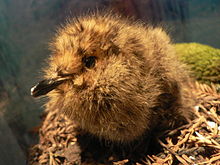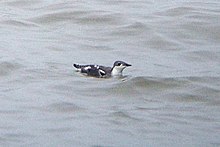Brachyramphus
| Brachyramphus | ||||||||
|---|---|---|---|---|---|---|---|---|

|
||||||||
| Systematics | ||||||||
|
||||||||
| Scientific name | ||||||||
| Brachyramphus | ||||||||
| Brandt , 1837 |
Brachyramphus is a genus of the cauliflower family, which includes three recent species. Until 1996 only two recent species were counted in the genus. The Kamchatka marmelalk ,which is now recognized as an independent species,was until then a subspecies of the marmelalk . Findings based on mtDNA and allozymes showed, however, that the Marmelalk is more closely related to the Short-beaked Alkaline and the KamchatkaMarmelalkis a sister species of the two. All three species are very closely related, however, the split into different species occurred within the last two to three million years.
All three recent species show an unusual behavior for alkenbirds. They usually breed individually and their nesting sites are often far from the coast.
Appearance
All three species reach a body length of about 25 centimeters. This makes them one of the very small alken birds. They differ from other alkenbirds in their small body size, their relatively slim build and their relatively long, pointed wings. They have extremely short legs that start very far back on the body. This is why short-billed falcons move around very clumsily on land. Swimming animals have their heads pointing upwards, their tails sticking out of the water and pointing upwards as well.
The plumage of the three species is very similar. In the magnificent dress , the entire body plumage is irregularly spotted dark chocolate brown on a white base color. In the plain dress , the plumage is exclusively black and white, so that it is reminiscent of the plumage of a guillemot .
The beak is black, short and pointed in all three species. The Kamchatka marmelalk has the greatest beak length. The Kurzschnabelalk has the shortest beak of the three species. Overall, it is slightly more curved and, due to the forward-facing springs, looks even smaller than it actually is.
Distribution area
All three recent species are limited to the North Pacific.
The North American Marmelalke breed on the west coast of North America from southern California via Oregon, Washington, British Columbia and the west coasts from Vancouver Island to southeast Alaska, and also in the west of the Aleutian Islands. However, the prerequisite is always an extensive population of old trees, which is why the populations in California, Oregon and Washington are small and fragmented because these requirements are no longer met.
The North American distribution area of the short-beaked limestone stretches from LeConte Bay in southeast Alaska via Prince William Sound , the Kenai Peninsula , Kodiak Island and Afognak Island to the Bering Strait and the Aleutian Islands . Short-billed falcons that breed on the coast of the Bering Strait have to move south after the breeding season because these waters freeze over. Otherwise, however, only a few southward migratory movements of North American birds can be observed. Individual wanderers, however, have been observed as far as southern British Columbia and the coasts of the US states of Washington and California.
In Siberia, the short-beaked lalk occurs mainly in the north of the Sea of Okhotsk . However, breeding birds can also be found on the coasts of the Chukchi Peninsula and on Karaginsky . Occasionally, however, short-beaked alks are observed significantly further south, for example on the Kuril Islands and on Hokkaidō . Short-billed falcons have also been observed significantly further north. It is possible that the species breeds on Wrangel Island as well .
The breeding area of the Kamchatka marmelalk extends along the coasts of the Sea of Okhotsk, the Kamchatka Peninsula and Sakhalin as far as Hokkaidō, where this species breeds occasionally. During the winter months, the more northerly breeding birds move south to avoid the sea ice.
Similar to the Kurzschanbelalk, Kamchatka jellyfish are often observed far outside their range. There are confirmed observations for both species in North America from Florida, Pennsylvania, New Jersey, New York, Massachusetts and Newfoundland, among others. The individual found in a fishing net in Lake Zurich in December 1997 is probably a Kamchatka marmelalk. A second, living individual of the Kamchatka marmel emerged in early November 2006 in Devon, England and was observed for several days.
Reproduction
None of the three species of the genus Brachyramphus breed in colonies, which is a rather unusual breeding behavior within the alkenvirds. Some of their nesting sites are very far inland. The short-billed lalk is a ground breeder that prefers to build its nests on hilltops above the tree line. This breeding behavior was already known at the beginning of the 20th century. Individuals of the indigenous population from the breeding region had reported this breeding behavior to ornithologists on various occasions, but were initially met with skepticism. All three species lay only one egg each, which is incubated by both parent birds.
The breeding behavior of the Kamchatka and Marmelalk was not known until the second half of the 20th century. Both species prefer to breed on tall, old trees. Their nest is located in the upper area of the respective nest tree on strong branches and cannot be seen from the ground or from the air.
The breeding behavior of the Marmelalke, which in North America became a symbol of efforts to preserve pristine forests on the coasts of the United States, has been particularly well studied. The breeding area of this species is usually 16.8 kilometers from the coast on average. Extreme nesting sites can be found up to 40 kilometers away. The typical nesting site is on old trees that are at least 200 years old. Typical of the forests in which jellyfish nest is a small undergrowth under the tall trees, but a pronounced growth of moss and epiphytes. The top of the trees is on average around 64 meters, the size of the forests in which Marmelalke breed is on average 206 hectares. The nest is located in the upper area of the nesting tree about one meter away from the tree trunk on a strong tree branch that offers a nesting platform about twenty by thirty centimeters. The nest is padded with lichen and moss and is usually not visible from above due to the branches hanging over it. Ground-breeding Marmelalke have also been observed in Alaska. Brooding Marmelalke each have two lateral breeding spots . The nestlings hatch after a breeding period of 27 to 30 days. Immediately after hatching, the nestling is fledged continuously for two days . The parent birds feed the nestling small fish, which they usually carry individually across their beak. The nestling period is 27 to 30 days, then the young bird usually flies to the sea alone, unaccompanied by the parent birds. It is not yet known how the young birds find their way to the sea. Some juveniles can see the sea shortly after taking off, but others have to travel long distances before sighting the sea. Young birds may remember the flight direction of the parent birds and use it as a guide.
Duration
All three species are classified as endangered by the IUCN. The main negative effects are the loss of breeding areas due to melting glaciers and marine pollution from ships and oil production facilities. The Exxon Valdez may have killed up to 10 percent of the world's population.
Exact inventory figures are not available for the Kamchatka marmelalk. The IUCN assumes that tens of thousands of birds of this species still exist: While the Kamchatka marmelalk is a rare bird on the coast of Hokkaidō, it can be seen more numerous on the coast of the Sea of Okhotsk. There are several regions in Russia where the species is even considered to be relatively common. These include the Amur estuary and the Kamchatka Peninsula. The species is much rarer in the Sakhalin region. Similar to the Marmelalk, this species is mainly threatened by the cutting down of the old forest, on which both species are dependent as nesting sites. Oil spills and drowning in fishing nets are also a major hazard for these two species.
species
The following three recent species belong to the genus Brachyramphus :
- Marmelalk ( Brachyramphus marmoratus )
- Short-beaked lalk ( Brachyramphus brevirostris )
- Kamchatka marmelalk ( Brachyramphus perdix ), sometimes also known as long-beaked lalk.
supporting documents
literature
- Anthony J. Gaston, Ian L. Jones: The Auks (= Bird Families of the World. Vol. 4 (recte 5)). Oxford University Press, Oxford et al. 1998, ISBN 0-19-854032-9 .
Single receipts
- ↑ Hans-Günther Bauer, Einhard Bezzel and Wolfgang Fiedler (eds.): The compendium of birds in Central Europe: Everything about biology, endangerment and protection. Volume 1: Nonpasseriformes - non-sparrow birds , Aula-Verlag Wiebelsheim, Wiesbaden 2005, ISBN 3-89104-647-2 , p. 572
- ↑ Gaston et al., P. 200
- ↑ Gaston et al., P. 194
- ↑ Gaston et al., P. 201
- ↑ Gaston et al., P. 201
- ↑ Gaston et al., P. 194
- ↑ Hans-Günther Bauer, Einhard Bezzel and Wolfgang Fiedler (eds.): The compendium of birds in Central Europe: Everything about biology, endangerment and protection. Volume 1: Nonpasseriformes - non-sparrow birds , Aula-Verlag Wiebelsheim, Wiesbaden 2005, ISBN 3-89104-647-2 , p. 573
- ↑ BBC News of November 11, 2006 , accessed October 17, 2010
- ↑ Gaston et al., P. 204
- ↑ Gaston et al., P. 197
- ↑ Gaston et al., P. 198
- ↑ Gaston et al., P. 198
- ↑ Gaston et al., P. 199
- ↑ BirdLife factsheet on the Kurzschnabelalk , accessed on October 17, 2010
- ↑ Gaston et al., P. 201
- ↑ BirdLife Factsheet on the Kamchatka Jamelalk , accessed on October 17, 2010


